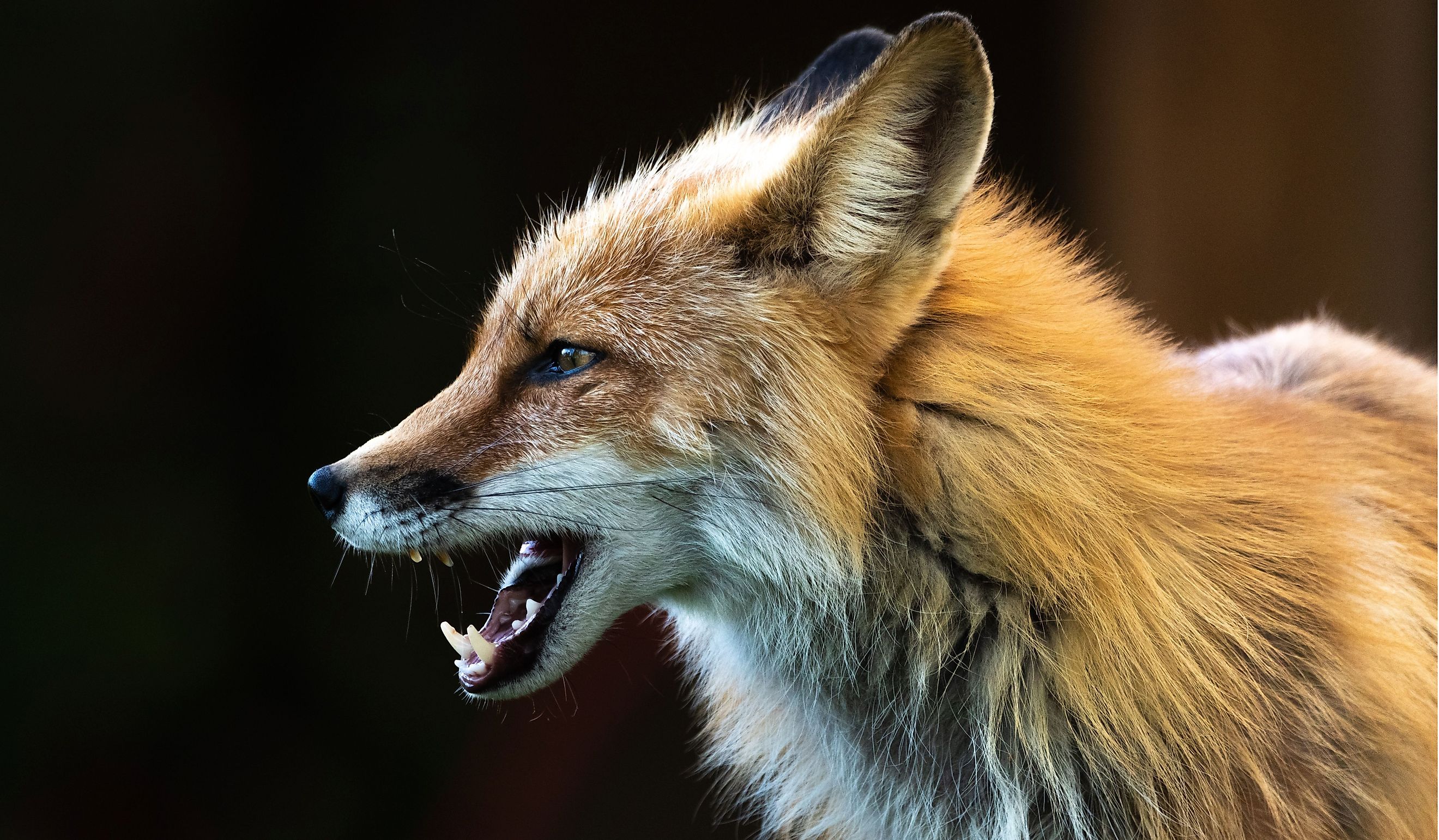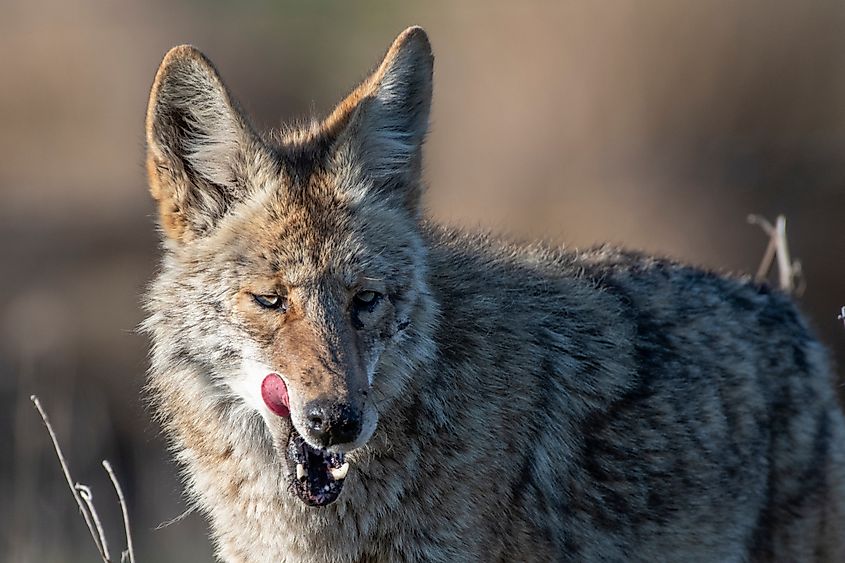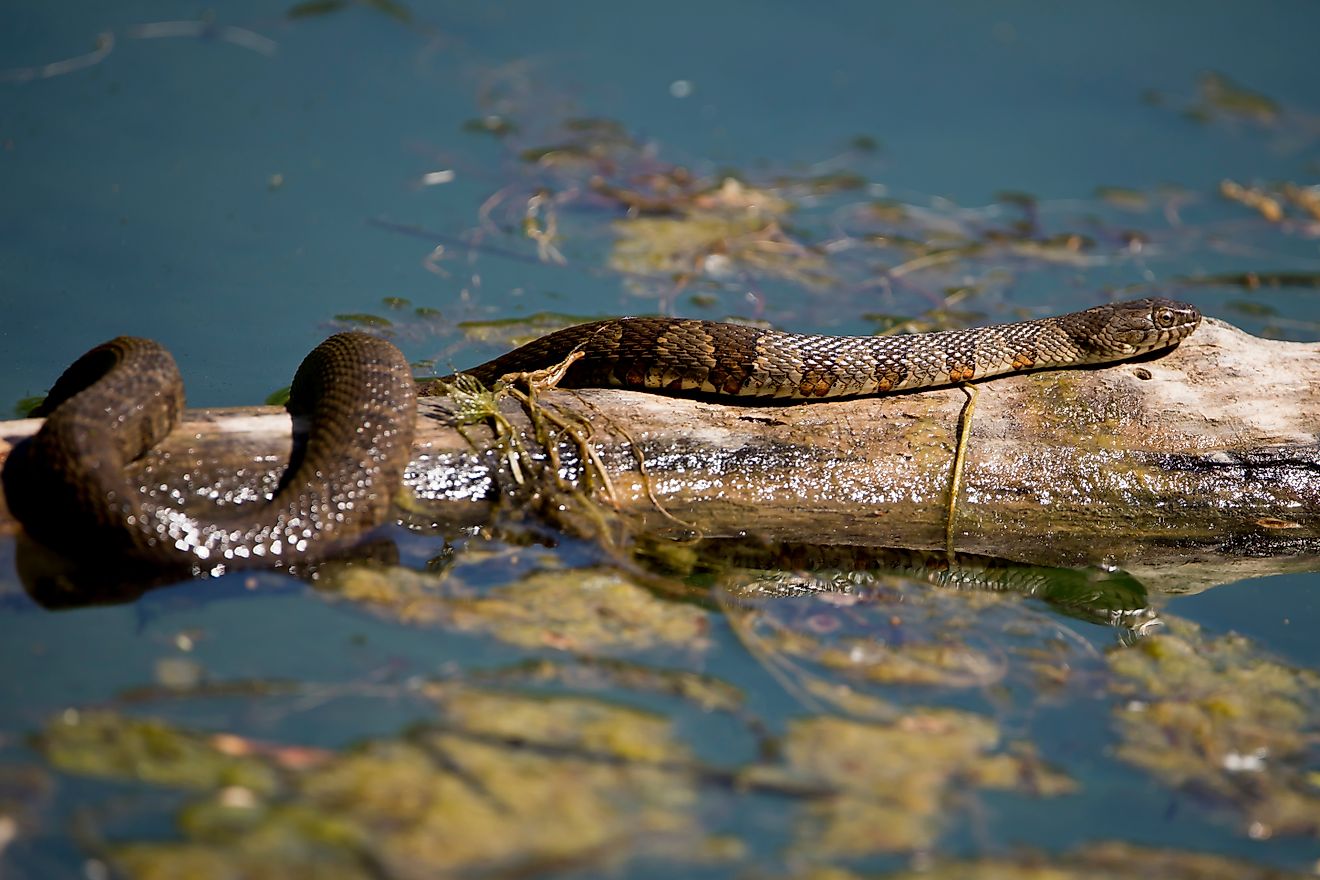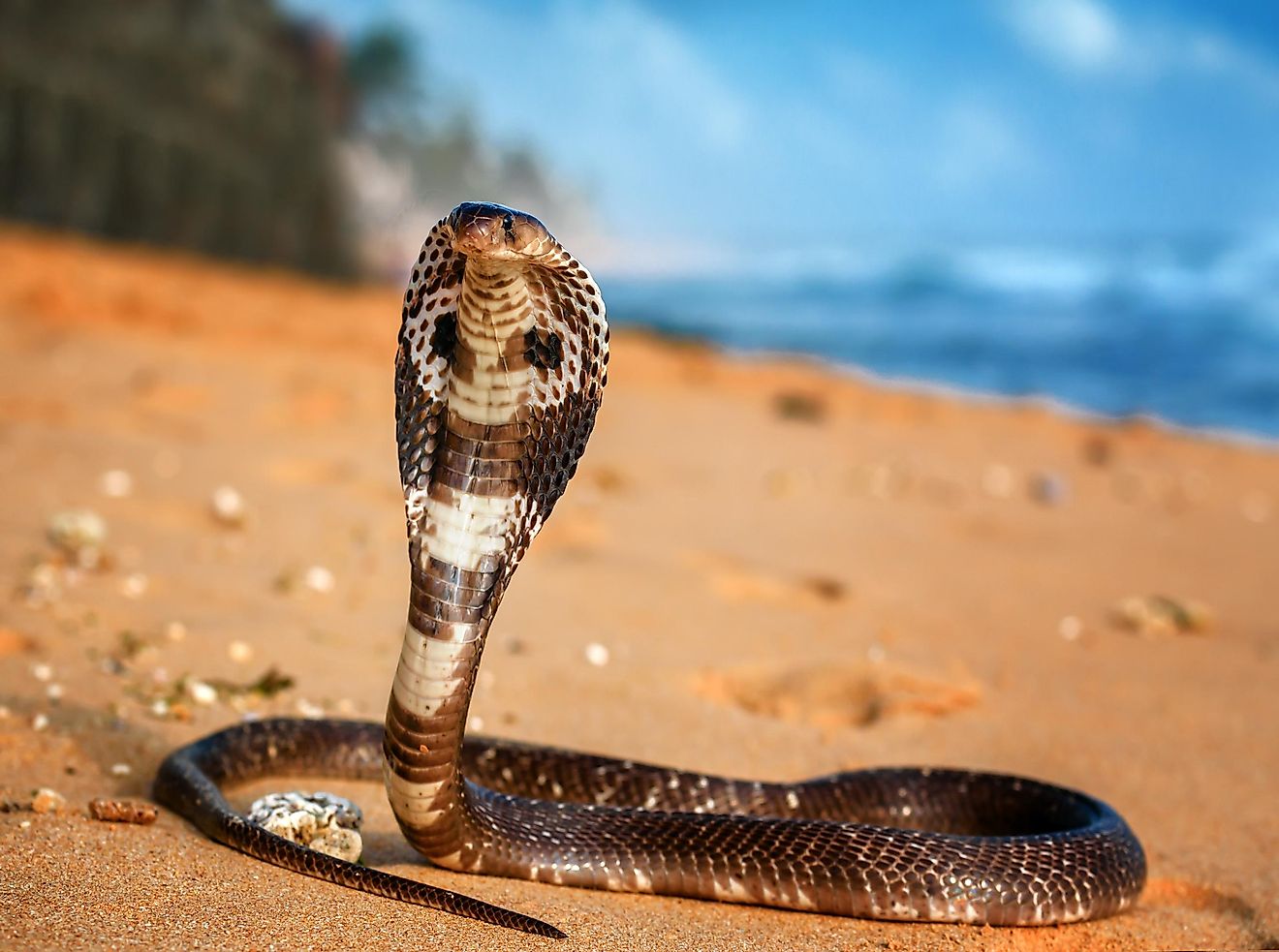
The 12 Deadliest Animals in Delaware
The State of Delaware borders the Atlantic Coastline and enjoys a wide range of natural habitats prime for the enjoyment of the wildlife native to the state. Many species call Delaware home, and most of them are totally harmless to humans. However, when it comes to being deadly, some of the gentlest of creatures can prove to be cold-hearted killers to those below them in the food chain. The following is a list of the 12 deadliest animals in Delaware.
Bald Eagle

Known to be one of the fiercest predators with the keenest eyesight, the Bald Eagle is a top predator in the State of Delaware, easily recognizable by its brown body, white head and tail, yellow talons, and beak. Their wingspan reaches nearly two meters across the sky as they scan the ground below for prey. Their habitat is high up in the trees, near coastlines and rivers. Harmless to humans, the Bald Eagle is deadly to small animals. They zero in on their prey from high above, choose their target, and attack. They feast on small rodents, fish, crustaceans, and snakes. While enjoying life at the top of the food chain, bald eagles can sometimes pose a threat to small pets such as cats and small-sized dogs. Their graceful presence exudes dignity and strength.
Coyote

The call of Delaware’s Coyote has the power to send chills down your spine, especially if heard while on a lonely country road late at night, and rightly so. They roam throughout the Appalachians and are easily recognized by their slender bodies, bushy tails, and white, brown, and red coloring. As nocturnal members of the canine family, they hunt in packs and prove to be deadly to larger animals such as deer. Their method of attack begins with biting the hind legs of their prey, and once they’re down, the coyote grips their neck with their powerful jaws and chokes their prey to death. Coyotes are not fussy eaters and will attack anything that comes along and will also scavenge on carrion. When all else fails, they will eat berries and fruit.
Timber Wolf

Delaware’s Timber Wolf exemplifies the mystic beauty of the animal that has appeared in lore and mythology for centuries, and it is no wonder why. Their luxurious fur and bushy tails enhance the strength and agility of their bodies, which are lean and muscular, designed to be constantly on the move. Wolves are often perceived as threats as they are known to attack livestock, being natural predators of larger prey, and have been hunted relentlessly. More recently, conservation efforts are attempting to bring back their population, and these majestic animals are regaining their place as top predators within the food chain. They can reach up to nearly 7 feet long and have the ability to run at speeds up to 37 miles (60 km) an hour. They are naturally designed to be deadly to their prey, which includes large game, and can move like lightning even through deep snow.
Timber Rattlesnake

Delaware’s Timber Rattlesnake is one of the two venomous snakes in the state. Its habitat includes low mountain ranges such as the Appalachians, and it is recognizable by its triangular head and large venomous glands on either side. Its scales range in color from golden yellow to grey and green, and sometimes a Timber Snake can be totally black. It has a stout body and a rattle at the end of its tale. Typically, Timber Snakes live in forests and play a significant role in controlling the rodent population. They prey on small mammals such as mice and voles, as well as ground birds. Their hunting methods include ambushing their prey unexpectedly, and though fatalities from a Timber Snakebite are few, these snakes can be deadly. Timber Snakes prefer to be left alone and will rattle their tails as a warning to anyone nearby, but if they feel threatened, they will strike, and their reach can extend quite a distance as they grow to be up to five feet long.
Bobcat

Closely resembling the Lynx, Delaware’s Bobcat is a medium-sized cat found throughout North America. It is a mystical creature that appears in European and Native American folklore. Famous for its bobbed tail, an encounter with one of these beautiful animals will not soon be forgotten. Their fur often appears either beige or dark brown in color, and they enjoy a vast range of habitats, including mountain ranges, open brushlands, and forests. Bobcats are carnivorous animals, and though they are relatively harmless to humans, they are deadly to snowshoe hares and cottontail rabbits and feast on them as often as they can. At times, males hunt larger game, including deer. For the most part, however, Bobcats help to keep the rodent and small mammal population in check and commonly hunt bats and birds, and they will also scavenge on carcasses left behind by other animals.
Red Fox

Foxes are a delight to encounter in the wild and pose little threat to humans, but don’t be fooled by their adorable appearance with their reddish-copper fur, black paws, and ears, bright eyes, and very bushy tail. Delaware’s Red Fox is a deadly predator of the smaller animals that are considered pests to humans, such as mice, rats, bugs, and snakes. Near the water, they will also hunt fish and crabs. They can be light as a feather, weighing in at just under 2 pounds on up to as high as 24 lbs. They live in forest burrows and dens where they have their babies and store food. A chance to meet with a fox in the wild is a true delight, and though they are a very serious threat to small animals, foxes capture the imagination and are often featured in children’s stories and picture books.
Snapping Turtle

Known to be aggressive and intimidating due to their size, Delaware’s Snapping Turtles can be a force to be reckoned with as their hooked jaws snap with remarkable force, and whoever gets caught in their path will certainly feel the pain. Weighing in at 16 kilos, their shell forms the bulk of their mass, measuring 20 to 30 centimeters in size. Snapping Turtles prefer to relax deep in mud; they are less aggressive when in water, but on land, they often lunge and snap at will. Snapping Turtles live in fresh water and feed on aquatic plants and animals, as well as snakes and small mammals. If one is spotted in the wild, unless it appears to be in danger or is injured, it is recommended that they be left alone and be easily recognizable due to their size and their coloring, which is often tan or black.
Lone Star Tick

Ticks are fear-inducing insects that rival even the biggest of spiders because they are difficult to detect and can carry seriously life-altering diseases with them, such as Lyme Disease. Delaware’s Lone Star Tick is the most common type of tick in the state and is uniquely identifiable by a white dot on its back. It lives in wetlands, meadows, and forests. They can be hiding in just about any place in a garden, including piles of brush and leaves or wherever small animals are found. They are aggressive when they bite, and their bites can be very painful. They travel efficiently, latching on to passing birds, small mammals, and even our beloved pets. When they bite, their bodies become engorged as they burrow beneath the skin, dining on their victim’s blood. Tick bites are not something to take lightly and can cause serious health problems and have reportedly caused humans to develop allergies to red meat and certain dairy products derived from mammals. People who have experienced the effects of Lyme disease can attest to the fact that, though these critters aren’t exactly deadly, they are most certainly a threat to our well-being.
Horseshoe Crab

Delaware’s Official State Marine animal is the ancient Horseshoe Crab, and its prehistoric physique dates back over 450 million years. They feature a round, horseshoe-like outer shell that is thick and impenetrable, with antennae and protruding spikes here and there. Their blood is bright blue and features compounds that cause it to thicken when it encounters toxins, which has been targeted for use in the biochemistry industry. Harvesting Horseshoe Crabs for medical purposes is considered problematic by the State of Delaware as it sometimes turns out to be deadly for the Horseshoe Crabs even though their blood contains healing properties. In their natural habitat, in and around the ocean, Horseshoe Crabs fill the beaches of Delaware in groves to perform mating rituals, which occur every year during a new moon cycle. They pose the greatest threat to algae, worms, and clams, which form the majority of their diet.
Eastern Copperhead

Delaware’s Eastern Copperhead is one of the two that share the state as their natural habitat as a pit viper with heat-sensing glands between their nostrils and eyes and both sides of their head. These sensors help the Eastern Copperhead to locate their prey, and they strike efficiently and swiftly when prey comes along. Identified by their crossband patterning and copper-colored head, they will attack without hesitation if threatened. Their bite is painful, their venom causes tissue damage, and can be fatal in elderly people or those with compromised immune systems. As dangerous as they can be to humans, the toll they take on the tick population makes it well worth the risk to have them around. As rats and mice are their preferred prey of choice, they aid in controlling the tick population by keeping the numbers of these rodents, who often carry ticks, in check. The Copperhead Snake is an integral part of the food chain in the state.
Brown Rat

Some breeds of rats are bred for the purpose of becoming domesticated pets, so they are not as feared as they once were, but in times past, a rat was considered a dangerous pest as they have been identified as disease carriers for lethal illnesses, including the bubonic plague. Delaware is home to the Brown Rat, also known as a street rat or a sewer rat. They live in caves, tunnels, sewers, and any other dark and dank place they can find out of harm’s way. Brown Rats are easy to identify due to their overly long tails and weigh in at roughly a pound in size, but their sharp teeth can cause big damage. Brown Rats are not finicky eaters and will consume just about anything edible in their path, but shrimp, eggs, rabbits, and birds are their favorite. Brown Rats should be swiftly eradicated from any domestic environment as the fleas they carry often are the real deadly culprits and carry many diseases, including typhus and salmonellosis.
Silver Haired Bat

Bats are an often feared and misunderstood animal, often associated in films and literature with vampires and haunted castles, but Delaware’s Silver Haired Bat prefers living in the forest as opposed to a castle, and they are typically elusive and difficult to locate. They form colonies while raising their young but are otherwise rather solitary in their everyday lives and can be found tucked in a secret place, safe from prying eyes, such as a nook in a stone wall or somewhere in a woodpile. The Silver Haired Bat is the worst nightmare of midges, grasshoppers, ants, crickets, and other creepy crawly critters in the insect world, which they dine upon in large quantities. Their wings span measures 8 to 12 inches in size, and they are to be given every measure of respect when encountered in the wild as their bite can pose serious, life-threatening diseases in pets and people.
Some of the deadliest animals in Delaware are surprisingly harmless to humans but still pack a deadly punch to the prey animals in their habitat. The Brown Rat, common in Delaware, is small and seemingly non-threatening, but it can carry deadly diseases. The Eastern Snapping Turtle is a relatively relaxed animal but has the force to bite fingers and toes from human hands and feet if put to the test. Then again, the adorable Red Fox is deceptively cute while being a prime predator of small animals. There are plenty of animals in the world that can do serious harm to humans, but the state of Delaware is quite safe for people when it comes to the wildlife population. Smaller animals like rabbits, mice, and voles don’t have it quite so easily and remain important to the diet of their predators, which is what makes them so deadly.











